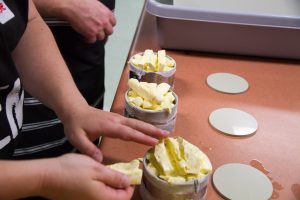Why is it important to cut the curd at a certain size, and why is moisture content just as important?
The size in which you cut the curd will affect several different characteristics of your cheese. Get it wrong and the cheese may not turn out as you had planned.
The cutting of the curd that has been formed after the addition of the rennet is one of the most critical aspects of cheesemaking. Cutting is the start of removing moisture process and will affect the final moisture of the cheese, as well as acidity, maturation rate, rinds, the yield of the cheese, mould growth, limiting or encouraging contaminants, and several more factors. All of these are very important factors that distinguish the exact characteristics and quality of your cheese.

After the curd is cut, it holds the solid constituents of the cheese which are moisture, fat, casein, and minerals plus it also contains whey, starter culture, and rennet. Casein is vital for the structure of the curd and coagulation.
During coagulation, the casein forms a fibrous network that enmeshes all these components and holds them like a sponge. It will shrink and expel moisture in response to changes in stirring, temperature and acidity, and these are the means by which moisture expulsion is achieved in cheese curds.

The constituents that are gradually lost from this mesh network into the whey, after cutting, are the water, lactose, whey proteins, some minerals and a small amount of starter culture. The term used to describe the loss of these components is called syneresis.

The volume and the amount of these constituents that are either retained in or removed from the curd are very closely related to the surface area of the curd particle after it is cut. The general rule is that the smaller the size of the cut, the greater the surface area of the curd. With a greater surface area, there is also a faster loss of components into the whey.

To show this in a less scientific way: If I had four cloth items, all soaked in a bath of water. A washer, hand towel, a towel and a blanket and placed them all on the clothesline to dry. The smallest item, the washer is the easiest to remove the water from because it has a small surface area for its size. The blanket will take much more effort to remove the water.
To show this in a more scientific way: We started with 1 litre of milk and added rennet so that it formed one single cube of curd. We would have a 10cm cube of curd; the surface area would be 600cm cm² (6 sides to a cube). If that cube of curd were to be cut into 1cm cubes (Cheddar cheese is cut to this size), then we would have 100 cubes with a surface area of 6000cm². If we cut those 1cm cubes into 5mm cubes, then we would have 8000 cubes of curd with a surface area of 12,000cm². Simply put, a greater surface area means more loss of whey and constituents into the whey.
As cheesemakers, you also need to keep in mind how fast you cook the curds, so case hardening and how effective you are at stirring the curd so you do not break those curds into smaller pieces.
Effect of different cut sizes on surface area for 1 litre of curd
| Size of cube | No. of cubes | Surface area |
| 10 cm | 1 | 600 cm2 |
| 1 cm (Large cut) | 1 000 | 6,000 cm2 |
| ½ cm (Small cut) | 8 000 | 12,000 m2 |
Syneresis
As mentioned previously, this term refers to the process of curd particle contraction and expulsion of whey (moisture) from the curd. Syneresis is important because the whey contains lactose which is fermented by the starter culture to lactic acid and the moisture content dictates compliance to cheese type and plays a role in cheese quality. The formation of a coagulum is the first step in the process.
The factors outside of cutting that affect syneresis include:
- Milk composition in particular casein and fat composition: Milk from some breeds such as Friesians have lower casein content (and usually lower fat content) and this makes moisture expulsion slower. Also, milk with a high fat content from breeds such as Jerseys retains moisture in the cheese. Literally, the fat particles block the whey drainage channels in the curd.
- Milk acidity: Curds with increased acidity (natural or through ripening) lose moisture more rapidly than less acidic curd.
- Rate of acid development: The steady rate of acid development within the curd is the most important factor influencing moisture expulsion. It is the rate, not the degree that must be adjusted during manufacture to suit moisture expulsion.
- Temperature: Moisture expulsion increases as temperature increases. It is most rapid following cutting after which the rate steadily decreases. Cheesemakers exploit this by cooking the curd immediately after cutting when making cheese varieties with lower moisture content. As curd is a poor conductor of heat, care must be taken to ensure heating does not happen at too fast a rate as this will result in case hardening of the curd particles. This condition will lead to a loss of yield.
- Agitation: Stirring curd in the whey reduces moisture content. This effect relies on breaking up clumps and the ‘collision effect’ of the curd particles.
- Salting: The amount of salt added to curd is the final method of adjusting moisture content; however, it is only effective in compensating for small differences as it affects curd fusion and cheese quality if too much additional salt is added.
- Pressing: Curds that are hooped without being placed in a press are still under some pressure, from the curds and whey at the top of the hoop. The taller the hoop, the greater the volume of curds and whey, and the higher the pressure.



